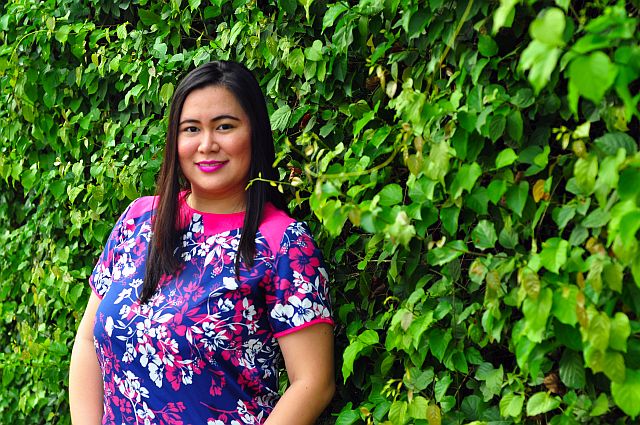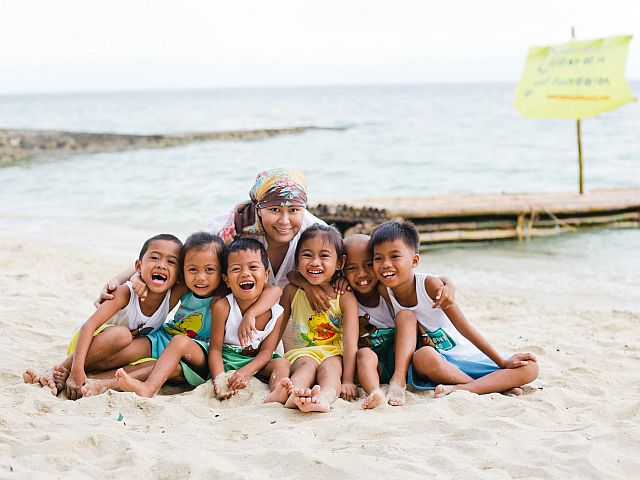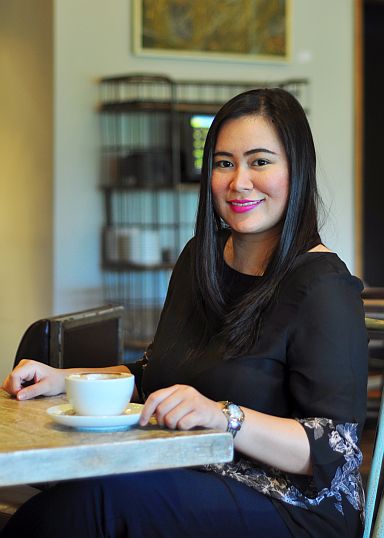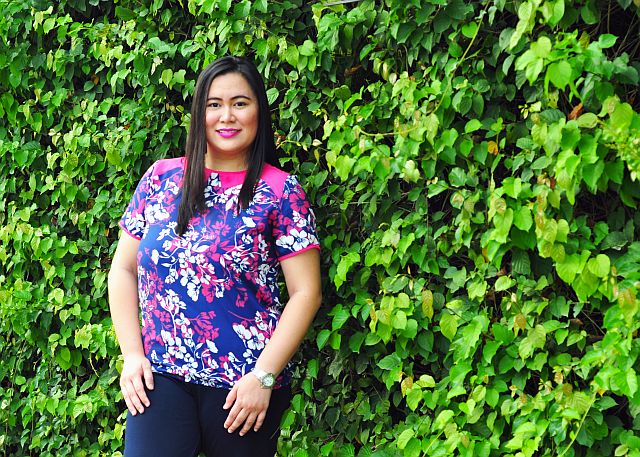
Jonnette Alquizola
SHE could be that classmate back in school who liked going out with her friends, is fond of children, and had a knack for teaching dance lessons. Then one fine ordinary school day, her life turned upside-down.
Jonnette Alquizola, Founder of the Children of the Coast, was 22 years old when she was diagnosed with ewing’s sarcoma, a very rare type of cancer that grows in the bones. It mostly affects children and white Americans. Clearly, for Jonnette, she’s neither both.
When you fight something like cancer, you’re not looking at a person who sees gender, beauty, background, or the figures in your bank. It doesn’t care who you are. Cancer, plain and simple, sucks. Things got real when her hair started to fall off. But one thing you can change is your outlook and Jonnette refused to see herself as a victim. She put on a wig and went out on a romantic date.
Fast forward to four years, the refined and outspoken Jonnette had a coffee date with the Play! pool and her smile brightened even more when the topic of Women’s Month was brought up. How can she not when she’s now the mother of over 5,000 children and who, at the same time, runs the family’s hotel business, Allure Hotel and Suites?
Children of the Coast Foundation focuses on the sanitation, health and nutrition of the children in the indigent communities in Cebu. Jonnette started with six children in Badian whom she met a year after she was diagnosed. She refers to them as her first born. Being sick was a gift. It drove her to give hope to the world one child at a time.
Cancer or not, her story is an inspiration to the many women out there who are struggling but chose to fight, whatever it is they are fighting for.
Women owe it to themselves to feel pretty, to love harder, and to enjoy life longer. (BHQ)
When you first consulted your “back pains” to a doctor, who was with you?
I was studying in Australia and early that year, I was already feeling back pains. One night, grabe siya kasakit. I was living in a dorm inside the campus. Ni-grabe ang back pains that I could not breathe, so nigawas ko and took a taxi to the ER of a nearby hospital, on my own. It was a Saturday night and my friends were partying and if I’d call them, there’s little chance that they’d hear their phones and they were probably drunk.
When the nurses were attending to me, that was when I called my friends. But they sent me home because they also thought that it was just back pain.

Jonnette with the original Children of the Coast
It was pure timing that a week after, it was already spring break and I went home here in the country and brought three-days worth of clothes.
When I was here, I was still in so much pain so I told my father nga magpa-check up nalang ko daan before going back to Australia because it’s cheaper here and we have doctors that we know. So I went, mao to nga wa nako nakabalik. I never got to take my flight back to Australia.
What’s Ewing Sarcoma?
It’s a rare type of cancer of the bone, mine was on my spine. I was diagnosed in 2012, I was 22 years old. I just thought it was muscle pains but when I was sent to the hospital to have my MRI, the doctor saw a tumor on my spine already. They opened me up to get a sample, to see what it was and then they found it was Ewing Sarcoma.
In your doctor’s visit here, who was with you?
I was still alone but my father joined me later on.
At 22, how did you take in the information that you have a rare type of cancer on the spine?
It was so overwhelming, the sudden news that you cannot go back to Australia and stay here for the chemotherapy and that. I don’t think I ever got to process all of it, paspas kaayo tanan.
What was the first thing that came to your mind?
It’s not what it looks like in the movies, like you are going to be told that you only have x years of your life. And that you will have that “moment” and cry. You don’t have time for that. The doctor only told me that we will take things slow.
The next thing I knew, naupaw nako. That’s, I think when it started to become painful, not physically but that’s when you are absorbing everything already and realize that you are indeed sick. My doctor told me that my hair will fall off slowly after my first chemotherapy. I began seeing strands of hairs on my bed, more than the usual hair fall. So I decided to cut it short, apparently para di kaayo nako ma feel nga sakit kaayo to see all of your hair falling off. One time, when I went to a shower, the water pressure was enough to make my hair fall into the drain. That was when I stood there, and I just cried for the first time, and knew that “that was it.”
Does it have levels or stages?
This one, it has no stage. My case it was only either primary or metastatic. Metastatic, it means it has spread, in my case it’s primary so it was just contained in that area which is good. It means I have a chance, I can have it removed, and provided that I survive the treatment which is two years, I’d be okay, thankfully. It was two years in the hospital, of 17 cycle of chemotherapy, it was two years living in Chong Chua. I have all these complications from treatment, sige kog abonohan og blood. After two years and three surgeries, I was okay. And now, I’m on a “mission” for two years now. My diagnosis was in 2012, I completed 2014.
What was the procedure like on a daily basis?
For breast cancer, it’s six cycles of chemotherapy. For my type, it’s 17 chemotherapy sessions and half of those are five days considered as one. The first chemotherapy is one day, the second chemotherapy is five days, one day again, five days again until I reached the needed 17 cycles. I would have that one month break then go back. After my 10th or 11th session, my body was not responding well. I would have blood tests every day at home because my blood count would drop. I got sent to the ER on an ambulance like three or four times already.
Was this in the middle of the night?
The first one, I just had a nosebleed and it wouldn’t stop because my platelets were down. It was two years of that. When I was diagnosed my doctor told me that I was lucky because it’s the treatable kind of cancer however, this is a very risky kind of treatment and is very aggressive. There was no guarantee that I can get through the treatment, older people cannot tolerate this kind of treatment, good thing I was young.
Ewing Sarcoma is more common among white children, like the Caucasians. For some reason, I am not white and not a child, I was 22 then, but still it chose me. But I survived after two years.
Who were your strong support system while going through it?
As vain as it is, I would take selfies and send them to my
really good friends, just to have that sense of support. I actually isolated myself for a year. I would just be at the hospital and at home. My good friends are all in Australia, that where I was studying naman for a while so wala kaayo diri. So I isolated myself because I didn’t know how to deal with it. I’m the only child, my parents are still here but they are no longer together. When I would go out of the house, I wore a wig because I didn’t want to feel sick. I did not want people to see me sick and give me that pity look.
When I was recovering na, I was judging a pageant. I had my radiation in the morning while I judged a pageant at night. Everytime I get invited to talk to cancer patients, my best advice is for them is to wear a wig. It makes all the difference in the world, when we are out there, nobody knows you are sick, nobody feels bad for you.
Go on and feel pretty. I even went out on a date with a guy who did not even know, I just had lunch with him. Every cell in your body is already telling you that you are sick and dying. At least, your heart has a positive attitude. (laughs)
Going through that, how were you able to convince yourself that things are going to be okay?
In my hospital bed, I have this photo of these six kids, the original Children of the Coast. I had their photo on my bedside. There are times nga kapoy na bitaw kaayo, you really cannot fight anymore, lipong naka and your blood counts are not getting any better. But I’d always say to myself, “eyes on the prize.” When I found out that my type of cancer was rare, and yet it chose me, it’s for a reason and they are my reason.
When did the Children of the Coast start?
After I isolated myself for a year, that was when I started the Children of the Coast. I was all ready to tell the world about it and knew that I knew that I had better chance of living. Children of the Coast started in 2013 and it was because I was at the beach house and saw these children. I used to teach dancing to children, so hilig ko’g bata. Every Christmas or birthdays, mag conduct gyud mig outreach programs. I was at our beach house in Badian, where I was recovering from treatment when I saw these kids nga niduol lang nako and then gave them food. Because of that, everytime I’m home for a weekend to recover from chemotherapy, mangita na sila nako and join me for breakfast, that was my sign.
What were the kids like?
They were kids of fishermen. Every time they would see my car and hear my voice, they would approach me. They were my first six children and my first-born, that’s why I called them Children of the Coast and they eventually started growing and growing. From six, we are now supporting 7,800 children all over Cebu, in public schools where we provide year-long health, nutrition and education program. I want it to be sustainable, not a one-time thing. We go back to communities, slowly every month.
How do you manage your time?
For Children of the Coast, I have four full-time staff and two part-time, and two interns. So, it’s doable. I’m lucky that I have my hotel team to work also.
What’s the most satisfying part of seeing your dream finally coming true, through Children of the Coast?
When the kids wash their hands properly. I know it’s very pettty but that’s what I teach so when I go and serve them lunch, no matter how hungry they are, they sit and stand up again to run to the washing area to wash their hands. For me, it’s like, “they remember and I know I am doing my work and I know that I am doing it properly.” It’s part of our hygiene class. It should be behavioral change for children and should be sustainable. No matter how you give them random things, the kids won’t learn that way. You just don’t give, it’s not enough. With children, you have to work with their minds. We published our coloring book, which is about hygiene and health with the approval of the Department of Health (DOH). All of our 7,800 kids have that book and we still have 4,000 books to give.
Did you ever ask God why, of all people, it had to be you?
Of course, I did. But then seeing my work now, makaingon sad ko nga “thank you for giving it to me.” I always wanted to do charity work but na busy nako sa mga negosyo, syempre na-distract nako. So when this happened, maybe this is for me. People asked us how we have grown into a foundation in just two years and it’s not privately funded. From six children to 7,800 in two years. It is also not personally funded completely, the only thing that my family funds is the staff pay, while all our programs are externally funded. It’s just people who saw our work and who decided to help and continue to help.
If cancer did not happen, would you see yourself staying here in the country?
I would be staying but for the businesses. I would still be happy but not as happy as I am now.
What do you usually do when you take a break?
This may sound so lame and cliche, but for me this doesn’t feel like work and I always refer to my kids as my children, it’s just being a mother to them.
When I’m my office and I’m all tired, I want to go to the school and play with the kids—that’s my break. I don’t need a break away from it. And I’m lucky that I live a comfortable life, and there ‘s a team of people who take care of my health, I just don’t need a break from it. It’s exhausting physically but it really makes me happy because it reminds me of the two long years in the hospital, why I was given sickness and why I was made to recover from it.
On a more personal level, are you dating someone now?
I’m seeing someone right now. We met two years ago when I was still in a relationship, which eventually it did not work out. I was dating someone back then, this guy was at that party. He remembered me but obviously I did not really noticed him. He added me on Facebook, at that time, which I did not accept. I met him again and searched him on Facebook, because we were talking and we have so many things in common. When I get to his profile, I saw the pending friend request. So I messaged him, asking when was this friend request and said it was like two years ago (laughs).
What’s your message to women who are struggling as you are?
Find something that’s going to inspire you to just fight. Find something, whatever it is that will inspire you because what works for me might not work for you. A photo of the children in Badian at your bedside might not work for you, but if it’s a photo of Brad Pitt, then go for it. Find that one thing that’s going to keep you loving, keep fighting and keep living.
And for cancer patients, the most profound advice I can give is wear a wig and feel pretty, and go out on a date. My date was so funny because I don’t think he knew, I don’t think he did. The wind was so strong, I was all holding my wig, as I thought that this should better hold on (laughs).



